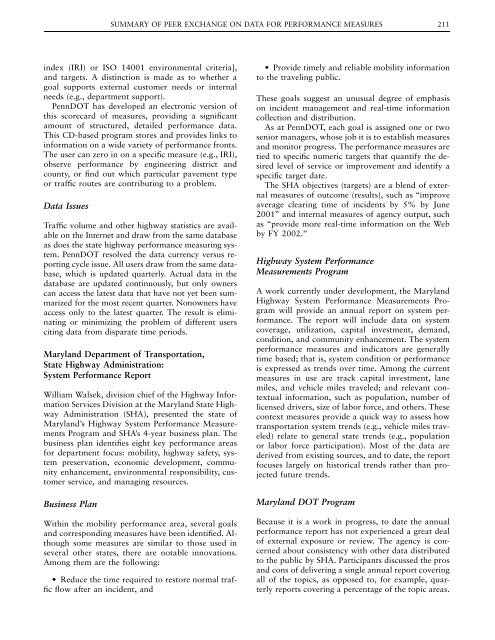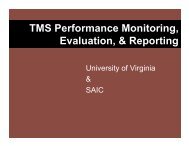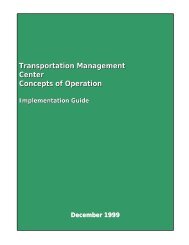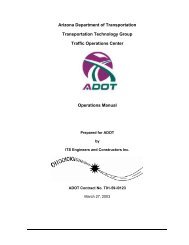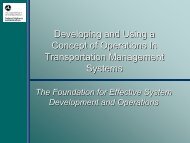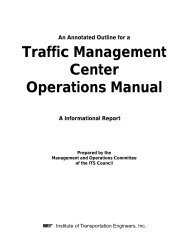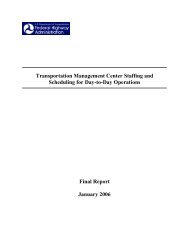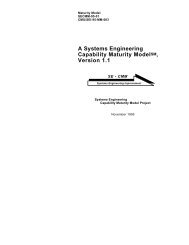210 PERFORMANCE MEASURES TO IMPROVE TRANSPORTATION SYSTEMS AND AGENCY OPERATIONStant task to undertake. Integrating the data into theplanning and programming processes will follow.California is not yet using data to prioritize or toprogram system projects and services but instead toevaluate existing projects and to provide informationto local decision makers and customers to use as theywish.Kentucky <strong>Transportation</strong> CabinetRob Bostrom, transportation engineering specialistwith the Kentucky <strong>Transportation</strong> Cabinet (KyTC,the state’s DOT) presented information on Kentucky’suse of performance measures in the planningprocess and their relation to KyTC’s quality initiatives.The main goals of the quality initiatives are toensure mobility and access, support economic development,continually improve organizational performance,and strengthen customer and stakeholder relationships.Overall emphasis is placed on improvedperformance in the areas of project delivery, safety,human resources, and system preservation.The presentation of KyTC’s performance measuresefforts emphasized three units at KyTC: the Divisionof Multimodal Programs, the Division of Planning,and the Kentucky <strong>Transportation</strong> Center (a researchunit affiliated with the University of Kentucky).Division of Multimodal ProgramsPerformance measures are used in a range of planningand analysis support functions, including thefollowing:• Travel demand modeling;• Air quality (including emission reduction andstate implementation plan compliance);• Traffic forecasting (timeliness, charging costs toprojects);• Mobility (cost of congestion); and• Small urban area studies.Pilot mobility evaluation programs are under way,testing measures including travel time, travel reliability,and congestion.Division of PlanningThe planning division at KyTC encompasses numerousanalytical support functions including GIS, highwayinformation systems, and TMSs. Performancemeasures are used in each of these systems to improveperformance and quality of data provided foruse by others. They include organizational performanceand program quality measures, such as degreeof accuracy of data sets, timeliness of inventory, andnumber of mistakes.Kentucky <strong>Transportation</strong> Center <strong>Research</strong> UnitThe transportation center has numerous planningrelatedstudies under way or ongoing, such as vehicleclassification analysis, load spectra development, andcost of construction delays. For example, the growthrate analysis study will improve estimation capabilitiesfor vehicle miles traveled and involve more sophisticatedforecasting and analysis techniques. Studiessuch as this are measured in terms of theirtimeliness and usefulness.Pennsylvania Department of <strong>Transportation</strong>’sStrategic AgendaBarbara Mason Haines of the Pennsylvania Departmentof <strong>Transportation</strong> (PennDOT) presented informationon the department’s ‘‘strategic agenda,’’ ascorecard of the measures information system, andstate data currency issues.Strategic Focus AreasThe strategic agenda is based on vision, mission, andvalue statements developed through a typical strategicplanning process. The eight strategic focus areasencompass most of the issues of interest tackled byother state DOTs, such as mobility, customer focus,and safety. Of special interest in the PennDOT effortare strategies such as a ‘‘maintenance first’’ agenda,singling out the importance of innovation and technologyand building stronger relationships with partnerssuch as customers and suppliers. Each focus areais associated with one or more goals and correspondingobjectives, which tend to be high level or strategicin nature. That is, they emphasize relatively broadresults and are aimed at departmentwide processesand activities. Also noteworthy in PennDOT’sagenda is that each strategic focus area has an owneror leader who is responsible for the results.Scorecard of Measures Information SystemThe PennDOT strategic agenda includes a wellorganizedscorecard of measures that clearly lays outstrategic focus areas, goals, measures, measurementtools [the actual metric, e.g., international roughness
SUMMARY OF PEER EXCHANGE ON DATA FOR PERFORMANCE MEASURES 211index (IRI) or ISO 14001 environmental criteria],and targets. A distinction is made as to whether agoal supports external customer needs or internalneeds (e.g., department support).PennDOT has developed an electronic version ofthis scorecard of measures, providing a significantamount of structured, detailed performance data.This CD-based program stores and provides links toinformation on a wide variety of performance fronts.The user can zero in on a specific measure (e.g., IRI),observe performance by engineering district andcounty, or find out which particular pavement typeor traffic routes are contributing to a problem.Data IssuesTraffic volume and other highway statistics are availableon the Internet and draw from the same databaseas does the state highway performance measuring system.PennDOT resolved the data currency versus reportingcycle issue. All users draw from the same database,which is updated quarterly. Actual data in thedatabase are updated continuously, but only ownerscan access the latest data that have not yet been summarizedfor the most recent quarter. Nonowners haveaccess only to the latest quarter. The result is eliminatingor minimizing the problem of different usersciting data from disparate time periods.Maryland Department of <strong>Transportation</strong>,State Highway Administration:System Performance ReportWilliam Walsek, division chief of the Highway InformationServices Division at the Maryland State HighwayAdministration (SHA), presented the state ofMaryland’s Highway System Performance MeasurementsProgram and SHA’s 4-year business plan. Thebusiness plan identifies eight key performance areasfor department focus: mobility, highway safety, systempreservation, economic development, communityenhancement, environmental responsibility, customerservice, and managing resources.Business PlanWithin the mobility performance area, several goalsand corresponding measures have been identified. Althoughsome measures are similar to those used inseveral other states, there are notable innovations.Among them are the following:• Reduce the time required to restore normal trafficflow after an incident, and• Provide timely and reliable mobility informationto the traveling public.These goals suggest an unusual degree of emphasison incident management and real-time informationcollection and distribution.As at PennDOT, each goal is assigned one or twosenior managers, whose job it is to establish measuresand monitor progress. The performance measures aretied to specific numeric targets that quantify the desiredlevel of service or improvement and identify aspecific target date.The SHA objectives (targets) are a blend of externalmeasures of outcome (results), such as ‘‘improveaverage clearing time of incidents by 5% by June2001’’ and internal measures of agency output, suchas ‘‘provide more real-time information on the Webby FY 2002.’’Highway System PerformanceMeasurements ProgramA work currently under development, the MarylandHighway System Performance Measurements Programwill provide an annual report on system performance.The report will include data on systemcoverage, utilization, capital investment, demand,condition, and community enhancement. The systemperformance measures and indicators are generallytime based; that is, system condition or performanceis expressed as trends over time. Among the currentmeasures in use are track capital investment, lanemiles, and vehicle miles traveled; and relevant contextualinformation, such as population, number oflicensed drivers, size of labor force, and others. Thesecontext measures provide a quick way to assess howtransportation system trends (e.g., vehicle miles traveled)relate to general state trends (e.g., populationor labor force participation). Most of the data arederived from existing sources, and to date, the reportfocuses largely on historical trends rather than projectedfuture trends.Maryland DOT ProgramBecause it is a work in progress, to date the annualperformance report has not experienced a great dealof external exposure or review. The agency is concernedabout consistency with other data distributedto the public by SHA. Participants discussed the prosand cons of delivering a single annual report coveringall of the topics, as opposed to, for example, quarterlyreports covering a percentage of the topic areas.
- Page 5 and 6:
National Academy of SciencesNationa
- Page 7 and 8:
Workshop Summary ..................
- Page 9:
General OverviewIntroductionExecuti
- Page 12 and 13:
4 PERFORMANCE MEASURES TO IMPROVE T
- Page 14 and 15:
6 PERFORMANCE MEASURES TO IMPROVE T
- Page 18 and 19:
10 PERFORMANCE MEASURES TO IMPROVE
- Page 20 and 21:
12 PERFORMANCE MEASURES TO IMPROVE
- Page 23:
Linking Performance Measures withDe
- Page 26 and 27:
18 PERFORMANCE MEASURES TO IMPROVE
- Page 28 and 29:
20 PERFORMANCE MEASURES TO IMPROVE
- Page 30 and 31:
22 PERFORMANCE MEASURES TO IMPROVE
- Page 32 and 33:
24 PERFORMANCE MEASURES TO IMPROVE
- Page 34 and 35:
26 PERFORMANCE MEASURES TO IMPROVE
- Page 36 and 37:
28 PERFORMANCE MEASURES TO IMPROVE
- Page 38 and 39:
30 PERFORMANCE MEASURES TO IMPROVE
- Page 40 and 41:
32 PERFORMANCE MEASURES TO IMPROVE
- Page 42 and 43:
Panel DiscussionJohn Poorman, Capit
- Page 44 and 45:
36 PERFORMANCE MEASURES TO IMPROVE
- Page 46 and 47:
38 PERFORMANCE MEASURES TO IMPROVE
- Page 48 and 49:
Workshop SummaryJohn Basilica, Loui
- Page 50 and 51:
42 PERFORMANCE MEASURES TO IMPROVE
- Page 52 and 53:
44 PERFORMANCE MEASURES TO IMPROVE
- Page 55 and 56:
RESOURCE PAPERImplementing Performa
- Page 57 and 58:
IMPLEMENTING PERFORMANCE MEASUREMEN
- Page 59 and 60:
IMPLEMENTING PERFORMANCE MEASUREMEN
- Page 61 and 62:
IMPLEMENTING PERFORMANCE MEASUREMEN
- Page 63 and 64:
IMPLEMENTING PERFORMANCE MEASUREMEN
- Page 65 and 66:
IMPLEMENTING PERFORMANCE MEASUREMEN
- Page 67 and 68:
Panel DiscussionJennifer Finch, Col
- Page 69 and 70:
FIGURE 2Level of measures and align
- Page 71 and 72:
PANEL DISCUSSION: AGENCY IMPLEMENTA
- Page 73 and 74:
PANEL DISCUSSION: AGENCY IMPLEMENTA
- Page 75 and 76:
PANEL DISCUSSION: AGENCY IMPLEMENTA
- Page 77 and 78:
PANEL DISCUSSION: AGENCY IMPLEMENTA
- Page 79 and 80:
WORKSHOP SUMMARY: AGENCY IMPLEMENTA
- Page 81:
Selecting Measures, Data Needs, and
- Page 84 and 85:
76 PERFORMANCE MEASURES TO IMPROVE
- Page 86 and 87:
78 PERFORMANCE MEASURES TO IMPROVE
- Page 88 and 89:
80 PERFORMANCE MEASURES TO IMPROVE
- Page 90 and 91:
82 PERFORMANCE MEASURES TO IMPROVE
- Page 92 and 93:
84 PERFORMANCE MEASURES TO IMPROVE
- Page 94 and 95:
86 PERFORMANCE MEASURES TO IMPROVE
- Page 96 and 97:
Panel Discussion, Part 1Anita Vande
- Page 98 and 99:
90 PERFORMANCE MEASURES TO IMPROVE
- Page 100 and 101:
92 PERFORMANCE MEASURES TO IMPROVE
- Page 102 and 103:
Panel Discussion, Part 2Douglas Zim
- Page 104 and 105:
FIGURE 11 Example data
- Page 106 and 107:
98 PERFORMANCE MEASURES TO IMPROVE
- Page 108 and 109:
Workshop SummaryBrenda Berg, Trans
- Page 110 and 111:
102 PERFORMANCE MEASURES TO IMPROVE
- Page 113 and 114:
RESOURCE PAPERMeasuring That Which
- Page 115 and 116:
MEASURING THAT WHICH CANNOT BE MEAS
- Page 117 and 118:
TABLE 1Sustainability MeasuresNewma
- Page 119 and 120:
MEASURING THAT WHICH CANNOT BE MEAS
- Page 121 and 122:
MEASURING THAT WHICH CANNOT BE MEAS
- Page 123 and 124:
MEASURING THAT WHICH CANNOT BE MEAS
- Page 125 and 126:
MEASURING THAT WHICH CANNOT BE MEAS
- Page 127 and 128:
MEASURING THAT WHICH CANNOT BE MEAS
- Page 129 and 130:
MEASURING THAT WHICH CANNOT BE MEAS
- Page 131 and 132:
MEASURING THAT WHICH CANNOT BE MEAS
- Page 133 and 134:
MEASURING THAT WHICH CANNOT BE MEAS
- Page 135 and 136:
PANEL DISCUSSION: CONNECTING SYSTEM
- Page 137 and 138:
PANEL DISCUSSION: CONNECTING SYSTEM
- Page 139 and 140:
PANEL DISCUSSION: CONNECTING SYSTEM
- Page 141 and 142:
PANEL DISCUSSION: CONNECTING SYSTEM
- Page 143 and 144:
Workshop SummaryScott Bassett, Oreg
- Page 145:
Freight Performance MeasuresCurrent
- Page 148 and 149:
140 PERFORMANCE MEASURES TO IMPROVE
- Page 150 and 151:
142 PERFORMANCE MEASURES TO IMPROVE
- Page 152 and 153:
144 PERFORMANCE MEASURES TO IMPROVE
- Page 154 and 155:
146 PERFORMANCE MEASURES TO IMPROVE
- Page 156 and 157:
148 PERFORMANCE MEASURES TO IMPROVE
- Page 158 and 159:
150 PERFORMANCE MEASURES TO IMPROVE
- Page 160 and 161:
152 PERFORMANCE MEASURES TO IMPROVE
- Page 163 and 164:
APPENDIX ASummaries of 20 Poster Se
- Page 165 and 166:
SUMMARIES OF 20 POSTER SESSIONS 157
- Page 167 and 168: TABLE 1(continued) WSDOT Outcomes,
- Page 169 and 170: SUMMARIES OF 20 POSTER SESSIONS 161
- Page 171 and 172: SUMMARIES OF 20 POSTER SESSIONS 163
- Page 173 and 174: SUMMARIES OF 20 POSTER SESSIONS 165
- Page 175 and 176: SUMMARIES OF 20 POSTER SESSIONS 167
- Page 177 and 178: FIGURE 2 Sacramento Regional Transi
- Page 179 and 180: FIGURE 3Goal evaluation table: Chit
- Page 181 and 182: SUMMARIES OF 20 POSTER SESSIONS 173
- Page 183 and 184: SUMMARIES OF 20 POSTER SESSIONS 175
- Page 185 and 186: SUMMARIES OF 20 POSTER SESSIONS 177
- Page 187 and 188: TABLE 6Mobility Performance Measure
- Page 189 and 190: SUMMARIES OF 20 POSTER SESSIONS 181
- Page 191 and 192: SUMMARIES OF 20 POSTER SESSIONS 183
- Page 193 and 194: SUMMARIES OF 20 POSTER SESSIONS 185
- Page 195 and 196: FIGURE 13 MPAH lane-miles by roadwa
- Page 197 and 198: SUMMARIES OF 20 POSTER SESSIONS 189
- Page 199 and 200: SUMMARIES OF 20 POSTER SESSIONS 191
- Page 201 and 202: SUMMARIES OF 20 POSTER SESSIONS 193
- Page 203 and 204: SUMMARIES OF 20 POSTER SESSIONS 195
- Page 205 and 206: SUMMARIES OF 20 POSTER SESSIONS 197
- Page 207 and 208: SUMMARY OF PEER EXCHANGE ON DATA FO
- Page 209 and 210: SUMMARY OF PEER EXCHANGE ON DATA FO
- Page 211 and 212: SUMMARY OF PEER EXCHANGE ON DATA FO
- Page 213 and 214: SUMMARY OF PEER EXCHANGE ON DATA FO
- Page 215 and 216: SUMMARY OF PEER EXCHANGE ON DATA FO
- Page 217: SUMMARY OF PEER EXCHANGE ON DATA FO
- Page 221 and 222: SUMMARY OF PEER EXCHANGE ON DATA FO
- Page 223 and 224: APPENDIX C: RESEARCH STATEMENTS DEV
- Page 225 and 226: LIST OF PARTICIPANTS 217University,
- Page 227: LIST OF PARTICIPANTS 219Darwin Stua


